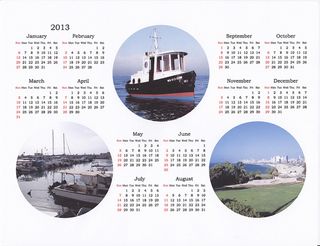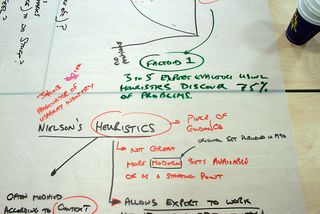6 scary statements that kill UI creativity
Jason Cranford Teague is back with more client frustrations and how to deal with them.
There are questions that can kill creativity, but even worse is the definitive statement. Questions are a passive aggressive way to attack, but a some phrases can shut down conversation without even an opening for more discussion.
Here are a few of the most common I've encountered and some recommendations on how to deal with them.
01. I've never seen it done that way before
What it feels like they are saying: Since I've never seen it work, it can't possibly work.

The Problem: You will encounter a lot of people who have a hard time imagining how your designs work. No matter how many static designs you show them, they never seem to 'get it'.
The Response: You will probably need a proof of concept. If you can, create a work prototype that shows your ideas as closely as possible, cutting down on the amount you have to explain and increasing on the amount you can show.
02. It's too early to think about that
What it feels like they are saying: You are wasting our time with irrelevancies.

The Problem: If you are more of a free-form thinker – as most creatives are – then you are often looking two or three steps ahead to see how your ideas may impact other ideas. I've heard this more often as I've worked on more and more agile projects where product owners and developers are focused on the task at hand, and often not looking at the bigger picture.
Get the Creative Bloq Newsletter
Daily design news, reviews, how-tos and more, as picked by the editors.
The Response: Think carefully: is what you are proposing irrelevant? If it's not, and it's important enough that it needs to be brought into the conversation now, stick to your guns. Sometimes even questions that cannot be answered at the moment need to asked so that as answers appear, they make sense. Remember: Answers are easy. It's asking the right questions that's hard.
03. We tried that two years ago
What it feels like they are saying: It didn't work back then so it's a bad idea that will never work.

The Problem: Timing is everything, and the idea that wasn't ready to work two years ago (or even possibly a few months ago) might finally be ripe. In the early 2000s a lot of people thought online video would never happen. The Internet was too slow, people liked 'quality TV', it was too costly/time-consuming to monitor everything being uploaded, the screen sizes were too small, and there was not any decent content were just a few of the arguments I regularly heard as to why we wouldn't see popular video posting.
And then YouTube happened. A lot of factors came together at the perfect moment including technical advances (Hi-speed Internet and the Flash video player) and YouTube just ignored other issues, allowing users to police each others content along with an 'ask for forgiveness rather than permission" policy about copyright.
The Response: Did they try it this exact same way before? Has the technology or competitive landscape changed? You're going to have to show them how they didn't try it this way and how things have changed since the last time the tried what you are proposing.
04. But [insert noted design pundit's name here] said that won't work
What it feels like they are saying: My pundit knows more than you do about this project.

The Problem: I have more than once found myself at what Jakob, Edward, and even Steve have said about user interface design. Design is not a set of precise rules or a way of thinking that produces precise answers. IT is messy, full of contradictions, and not subject to the particular dictates of any one school of thought.
The Response: The noted design pundit is not working one this product; you are. Of course, the person saying this may not know what they are talking about, but only parroting what they heard. So, listen to what they say the pundit said. Is it a valid point? Did you consider it already? work with them to understand why you may hove gone 'off-script' for your solution.
05. We already user-tested something like that
What it feels like they are saying: Users didn't like the thing we tested so this must be a bad idea too that will never work.

The Problem: Similar to the 'We tried that before' statement, this one comes with the assumption that once user tested and 'failed' a different take on the issue or simply a bit of maturity for the audience segment will not make the difference.
The Response: Look at what they tested, and then explain how your take on the problem is different and how the audience segment has changed since they tested their solution. The industry in which we work is constantly changing and shifting and what might have seemed like a bad idea just a few years ago becomes all the rage today.
06. No
What it feels like they are saying: No, you idiot.

The Problem: "No" is the ultimate conversation stopper. It can feel like a stone wall between you and your goal. There's no prevarication, no alternative negotiation. Just a negation of everything you are saying. If there is no explanation (Which there often is not) you don't know the logic or the reasoning, and often the person does not wish to elaborate further.
The Response: The only answer I've found is to simply ask, "why?" Not, "why did you say that?" or, "Why don't you like my idea?" Which are very different questions. Just, "Why?" Don't elaborate, simply ask why and leave it in their court to fill in the rest.
Words: Jason Cranford Teague
Jason Cranford Teague is a Senior Creative Director at Capital One and teaches workshops on experience design for developers, development for designs, and temporal design thinking.
Like this? Read these...

Thank you for reading 5 articles this month* Join now for unlimited access
Enjoy your first month for just £1 / $1 / €1
*Read 5 free articles per month without a subscription

Join now for unlimited access
Try first month for just £1 / $1 / €1
The Creative Bloq team is made up of a group of design fans, and has changed and evolved since Creative Bloq began back in 2012. The current website team consists of eight full-time members of staff: Editor Georgia Coggan, Deputy Editor Rosie Hilder, Ecommerce Editor Beren Neale, Senior News Editor Daniel Piper, Editor, Digital Art and 3D Ian Dean, Tech Reviews Editor Erlingur Einarsson, Ecommerce Writer Beth Nicholls and Staff Writer Natalie Fear, as well as a roster of freelancers from around the world. The ImagineFX magazine team also pitch in, ensuring that content from leading digital art publication ImagineFX is represented on Creative Bloq.
